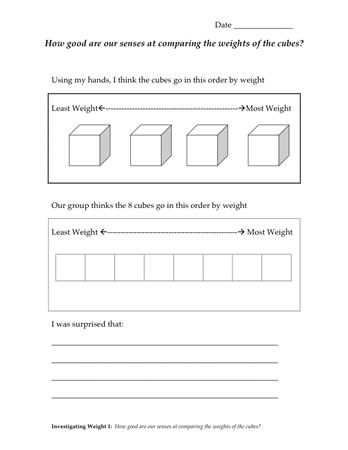How good are our senses at comparing the weights of the cubes?
Plan Investigating Weight 1
Children, being small, can be quite good at gauging weights. If they weren’t, they’d struggle under many heavy burdens. In this investigation, students explore how well they can compare weights using only their hands.
Formative Assessment
Available online at inquiryproject.terc.edu
Students first talk about evaluating weight with their senses. Working in groups, they then try to put the materials cubes in order using only the “felt weight” in their hands. When they see that different groups arrive at different orders, they consider the limitations of felt weight.
By the end of this investigation, students will see that they cannot always rely on their senses to compare weights. Some may suggest using some sort of “scale.”
Learning Goals
- to understand the limitations of “felt weight”
| Sequence of experiences | ||
|---|---|---|
| 1. Ask the question | All Class | 10 Mins |
| 2. Explore sensed weight | All Class | 5 Mins |
| 3. Order four cubes by felt weight | Pairs | 10 Mins |
| 4. Order eight cubes by felt weight | Small Groups | 10 Mins |
| 5. Make meaning | All Class | 10 Mins |
Materials and Preparation
For the class:- Post the investigation question in a place where all students can see it.
- Make a table on a whiteboard or flip chart to record students’ orderings of the cubes; an example can be found in Step 4.
- Try ordering the cubes by felt weight yourself; it’s harder than it looks.
- 3 objects that appear identical but have clearly different weights, e.g., 3 boxes of chalk containing different numbers of pieces or 3 salt shakers filled with different amounts of salt
- One pan balance
- 1 set of cubes with the names of the materials on the cubes
Notebook Pages
Can students use class data to answer the question, "How good are our senses at comparing the weight of cubes?"
You can find evidence by listening to students discuss and make meaning of the class data. Each group has posted their list of cubes ordered by "felt weight." There is agreement and disagreement.
As Joan interprets the points students make, she listens for students to:
- Identify instances where there is agreement on the weight order of the cubes (not seen in video) and where there are discrepancies (copper and steel).
- Note that these data make it difficult to support an unqualified claim (Our senses are good as long as cube weights are quite different, or if the cubes aren't very light or very heavy.).
After they hear evidence for both positions, give students a chance to change their position as a next step.






